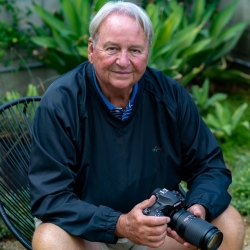Home > Topics > Post Processing > Adobe Lightroom & Adobe Camera Raw > Zone System Film Test and LAB Readings
Zone System Film Test and LAB Readings
-
AuthorTopic: Zone System Film Test and LAB Readings Read 442 Times
-
Adobe Lightroom & Adobe Camera Rawon: February 21, 2023 at 9:19 pm
Not sure where to post this question, but I will put it here. If it should be in another forum, just let me know.
After a 30-year hiatus, I have gotten a renewed interest in shooting black and white films. Of course, this means interest in the Zone System. I exposed a roll of 120 HP5+ on my Hasselblad 500 C/M. One frame for each of the Zones on the roll. I did this as a test of my equipment. I scanned the film and loaded the scans into LR. I had assumed that if my equipment and my technique were correct, I could use the LAB readout in LR to verify the exposures. For example, when I made lab readings of the luminance values in each of the Zones, I would get readings like Zone 5=50, Zone 0=0, and Zone 10=100. My actual readings are far different. Is my equipment or technique faulty, or are my assumptions about Zones and LAB values in error?
Any opinion, observations, or advice is welcome and appreciated.
Thanks
Ron
Re: Zone System Film Test and LAB ReadingsReply #1 on: February 21, 2023 at 9:31 pmI don’t believe we can equate the Zone System with L*a*b* values. Recall the Zone System was designed for handling the brightness range for film, which has a non-linear characteristic curve, while the L*a*b* system is linear. I would recommend that you simplify your approach to luminance by working within the parameters of a digital workflow, recognizing that black point varies with the kind of media you are using, and that you will see tonal separation in your photos to the extent that contiguous L* values differ from each other above the relevant Black Point. I think you could use the Zone System approach conceptually as rough guidance to identify roughly where within the tonal range various areas of your photo should fall, but don’t try to apply it with numerical rigour.
Re: Zone System Film Test and LAB ReadingsReply #2 on: February 21, 2023 at 10:23 pmThere is nothing in any Adobe raw converter that tells you anything about the exposure of raw data; RGB, Lab, or otherwise. You need a raw Histogram (and raw data without any rendering) to get that info.
For the scanned film, that’s also true as exposure takes place on the film, you’ve scanned an image into some color space, and the horse has left the barn long again.
The Lab values have no direct correlation to anything to do with exposure.
Author “Color Management for Photographers" & "Photoshop CC Color Management" (pluralsight.com)”
Re: Zone System Film Test and LAB ReadingsReply #3 on: February 22, 2023 at 11:01 amAR: “There is nothing in any Adobe raw converter that tells you anything about the exposure of raw data; RGB, Lab, or otherwise. You need a raw Histogram (and raw data without any rendering) to get that info.”
I would suggest here that for most common purposes there is also no need for photographers to access that information in the normal course of image editing.
AR: “For the scanned film, that’s also true as exposure takes place on the film, you’ve scanned an image into some color space, and the horse has left the barn long again.”
The interesting thing here for the context of the OP is that the colour space into which the film is scanned and the contrast curve guiding the default rendition end-up producing a set of values that have no particular relationship to the Zone System which may have guided the original film exposure with its film’s original characteristic curve.
AR: “The Lab values have no direct correlation to anything to do with exposure.”
Well, every pixel in the scanned film frame does have a Lab value resulting from the exposure in the scanning apparatus, whether a scanner or a camera. The operational issue for the OP is whether he needs to pay any attention to them, and for most purposes the answer is probably <No>. I think most photographers edit images based on the visual cues from the monitor with some reference to the histogram where helpful, without really watching specific Lab values. Of course where one needs to reproduce exact colour values, it’s a different story.
Re: Zone System Film Test and LAB ReadingsReply #4 on: February 22, 2023 at 1:21 pmMark and Andrew, thanks for your replies. I have read them and I think I understand your answers to my initial question.
My objective was to determine if my lens, shutter, iso, lightmeter, development, film, and shooting technique, combination are working together correctly to produce an accurately exposed image. The camera and lens are vintage 1980”s. I imagine my Pentax Digital Spot Meter is from the same era. I just want to verify that when I exposed a frame of the film for Zone 5, I actually was producing a Zone 5 exposure. I assumed that since Zone 5 should produce an 18% grey image, that when I examined the image with the LAB feature in LR, the LAB reading would be 50.
Since that is not a correct conclusion, can you offer a solution that would help me verify that my Zone 5 exposure has actually produced a Zone 5 negative? I am simply trying to verify that my material, equipment, and technique are producing an accurate exposure. Any advice would be appreciated.
Re: Zone System Film Test and LAB ReadingsReply #5 on: February 22, 2023 at 1:52 pmI suppose that with the use of a spectrodensitometer you may be able to take a density measurement of the supposed 18% gray neg and convert that density reading to a more familiar measurement of 50% gray, but having never needed to attempt any such thing I can’t vouch for such an approach. You’d have to check your old Zone System manuals to see what they recommend for testing the accuracy of a zone placement. It’s many decades ago for me, but I seem to recall it was largely visual.
But more important, why bother? Whatever is on the film, that’s water under the bridge for your whole archive. All that matters going forward is whether the scan data fits within the histogram without clipping black or white and the tonal distribution between those points looks workable in post-scan software. If it looks right it is right. Is there anything you do that really needs numerical accuracy?
Re: Zone System Film Test and LAB ReadingsReply #6 on: February 22, 2023 at 2:04 pm“I would suggest here that for most common purposes there is also no need for photographers to access that information in the normal course of image editing.”
I can’t (and will not) speak for all or even most photographers, only for one (me). The Histogram is very useful, hence the long video provided below. It tells me about the brightness distribution of the data in a fixed color space, as well clipping of colors and tones. It has nothing to do with exposure in anything but the very, very rare products that provide a raw Histogram. In that case, Lab values IF provided, are based on an assumption, too (which is probably why RawDigger doesn’t provide them). Rendered RGB values are fine.
A scan is also in a color space and has zero relationships to any exposure. Exposure is simply the amount of light striking the film or sensor and has two and only two attributes; aperture and shutter speed, which control how much light strikes the media.
The way to test exposure on film is to bracket, use a consistent development with the bracket and examine the film. Now we’re into densitometry.
If the final is a print, one must add that to the testing.
In the ’80s, when going to a good film school (ACCD), we had such an assignment. Shoot with our 4×5’s, using a color neg with a ‘recommended” ASA, a series of brackets. In the shot had to be a still life with a gray card. We shot 3 stops over and 3 stops under the meter’s recommendation (Incident meter, controlled studio lighting). The bracket was in 1/2 stops each way. All film processed identically and at the same time. Take each image into the color darkroom. Print each such the gray card in real life and the gray card in the print matches. This was our “control“. Examine each print; pick the exposure that provided the best-appearing print. And no, it wasn’t close to the exposure using the recommended ASA on the film box (which today is the case when doing a similar test with raw).
Everything you thought you wanted to know about Histograms
Another exhaustive 40-minute video examining:
What are histograms? In Photoshop, ACR, Lightroom.
Histograms: clipping color and tones, color spaces, and color gamut.
Histogram and Photoshop’s Level’s command.
Histograms don’t tell us our images are good (examples).
Misconceptions about histograms. How they lie.
Histograms and Expose To The Right (ETTR).
Are histograms useful and if so, how?
Low rez (YouTube): http://www.youtube.com/watch?v=EjPsP4HhHhE
High rez: http://digitaldog.net/files/Histogram_Video.mov
Author “Color Management for Photographers" & "Photoshop CC Color Management" (pluralsight.com)”
Re: Zone System Film Test and LAB ReadingsReply #7 on: February 22, 2023 at 2:09 pmYes, the histogram describing the image as rendered in one’s image editing app is indeed very useful. It’s the “raw histogram” from a bespoke app that I was suggesting would not normally be referenced by many.
Re: Zone System Film Test and LAB ReadingsReply #8 on: February 22, 2023 at 2:24 pm“It’s the “raw histogram” from a bespoke app that I was suggesting would not normally be referenced by many”.
True; for any photographer not wishing to understand the actual effect of exposure upon their raw data.
Author “Color Management for Photographers" & "Photoshop CC Color Management" (pluralsight.com)”
Re: Zone System Film Test and LAB ReadingsReply #9 on: February 22, 2023 at 5:46 pmSadly I think Ron is on a fool’s errand…there’s really no way to mix analog photography and digital technology and deploy vintage techniques like the Zone System-which was designed for the purpose of matching film exposure and processing time with enlarging paper contrast…
Rather than worrying about that you should worry about exposure and processing for the purpose of scanning.
So what sort of scanner are you using? That will go towards determining what sort of D-Max your scanner can handle.
-
AuthorPosts
- You must be logged in to reply to this topic.




